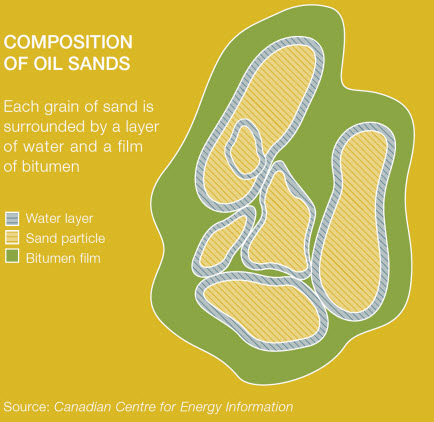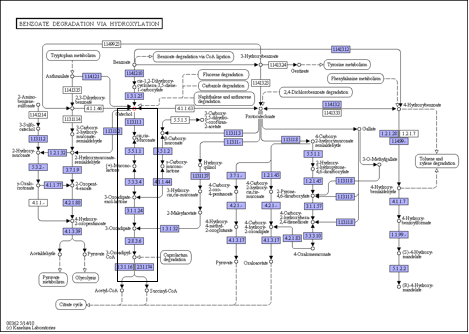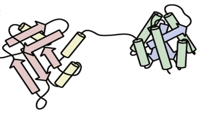Team:Toronto/Project
From 2010.igem.org
| Home | Project | Design | Protocols | Notebook | Results | Parts Submitted to the Registry | Modeling | Software Used | Human Practices | Safety | Team | Official Team Profile |
|---|
Contents |
Project Description
Background
Oil Sands
Oil sands are naturally occurring mixtures of sand or clay, water and an extremely dense and viscous form of petroleum called bitumen.
Bitumen is a collection of heavy hydrocarbons, which results from preferential microbial degradation of lighter hydrocarbons in oil reserves over geological time scales. These heavy oil reserves are some of the largest fossil fuel stores in the world with more stored energy than traditional oil reserves.Oil sands represent approximately 67% of the world’s total petroleum resource, with the two largest deposits being in Canada and Venezuela. Together they contain approximately 3.6 trillion barrels of oil, compared to 1.75 trillion barrels of conventional oil worldwide. The oil sands in the Athabasca Basin in northeastern Alberta, Canada represent the world’s largest resource estimated to contain over 1.7 trillion barrels of bitumen.
Tailings Ponds
Oil sands are developed either through open-pit mining or deep underground (in situ) production. In open-pit mining, hot water is used to separate bitumen from the mixture of sand and clay.
Each cubic meter of mined oil sands requires up to 3 m3 of water and produces about 4 m3 of slurry wastes containing sand, clay, water, unrecovered bitumen and dissolved inorganic and organic compounds. This mixture is then sent to a discontinued mine pit, referred to as a tailings pond. It is a large man-made collection of waste, which has a negative impact on the environment.
Over 70% of the water demand is met by recycling the recovered water. Even so, these wastewaters are accumulating at a rate of about 0.1-0.2 m3 per ton of oil sands processed. Recycling of the water back to the extraction process further concentrates contaminants as more waste material is added to the already contaminated water. It has been estimated that over 1 billion m3 of tailings pond water will be generated by the year 2025.
They are composed of a wide variety of chemical toxins. Amongst these are polycyclic aromatic hydrocarbons (PAHs), with Naphthalenes, Anthracenes and Fluorenes present at the highest concentrations. These compounds are toxic to the surrounding aquatic ecosystems, and have been shown to have an adverse effect on human health. PAHs are carcinogenic and are also known to have a negative impact on immune function, kidney function, liver function, reproduction and development.
Bioremediation
Bioremediation is the use of microorganisms to return the natural environment altered by contaminants to its original condition. It has been proposed as a possible method for the reclamation of land and water impacted by oil sands development. Although natural examples of these processes exist, they tend to be characterized by slow reaction rates and/or undesirable side reactions.
Over expression of rate limiting enzymes has enjoyed moderate success in overcoming some pathway limitations. However, because enzymes operate within complex, highly organized systems, there is increasing recognition within the metabolic engineering community that spatial organization offers an additional route for optimizing pathway efficiency.
Catechol
Pseudomonas putida, a microbe naturally present in tailings ponds, has the metabolic machinery needed to metabolize many toxins within the tailings ponds. This includes the capability to degrade certain PAHs in tailings ponds such as naphthalenes, anthracenes and fluorenes. These three major PAHs are degraded to form a common compound called catechol. However, this process is slow and inefficient. Since catechol is the common breakdown product in the breakdown of these PAHs, enhancing the breakdown of catechol may lead to an increase in the rate of PAH degradation. This project will look to evaluate how we can increase the degradation rate of catechol in order to achieve faster PAH breakdown.
The metabolic network present in P. putida for degrading catechol is highlighted by the black box in Figure 1. (http://www.genome.jp/kegg-bin/show_pathway?ko00362+C00090).
Figure 1. The degradation of catechol (ortho cleavage pathway) leads to common cellular metabolites, acetyl-CoA and Succinyl-CoA , through the action of five enzyme catalyzed reactions in Pseudomonas putida.
Metabolic Channeling
Metabolic channeling is the process whereby metabolic intermediates are channelled between the active sites of consecutive enzymes in a biochemical pathway. This serves to increase reaction efficiency by limiting the diffusion of metabolites into the surrounded cellular intracellular environment. Channelling provides a biochemical system with benefits such as:
- Enhancing unfavourable reactions
- Sequestering toxic intermediates
- Protecting unstable intermediates
- Preventing inhibition of other enzymes by the channelling intermediate
Channeling has been utilized in bioengineering to enhance the efficiency of desired biochemical systems. Some methods which have been utilized to mimic examples of metabolic channelling in nature are through:
- Immobilized Enzymes
- Fusion Proteins
- Scaffolds
Immobilized Enzymes Fusion Protein Scaffolding
The Project
Our project aims to take advantage of the catechol degradation pathway present in P. Putida by introducing metabolic channeling to increase the efficiency with which catechol is degraded. Besides being toxic in it's own right, we anticipate that accelerating the degradation of catechol, a common product of polyaromatic hydrocarbon (PAH) degradation, will result in increased PAH degradation. This hypothesis, supported by computer modeling will be tested in an E.coli model using the synthetic construction of several variations of the pathway involving the channeling of different pairs of enzymes by protein fusion.
Future Goals
Once we complete the characterization of the “Encapsulator” micro-compartment from the 2009 iGEM project, we will evaluate whether compartmentalization can further enhance the effects of metabolic channeling as compared to gene fusions. Ultimately, channeling will be introduced to target pathways in endogenous tailings ponds species (e.g. P. Putida) for application in the bioremediation of the tailings ponds.
 "
"





